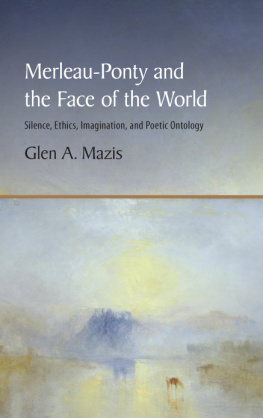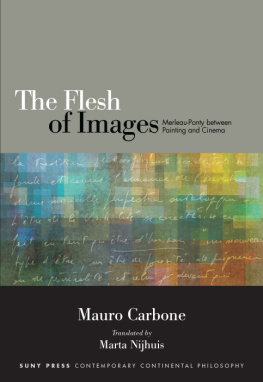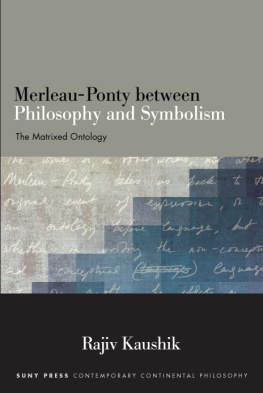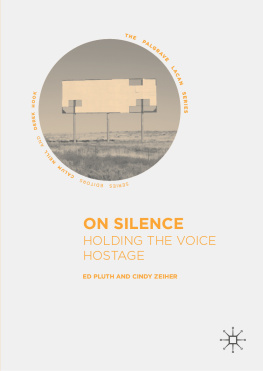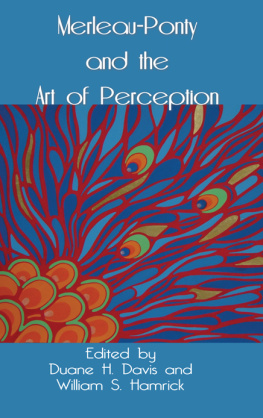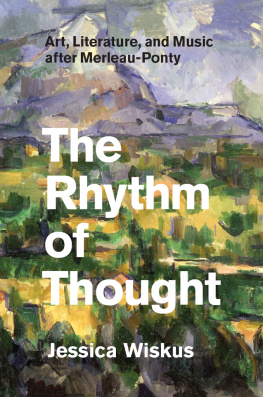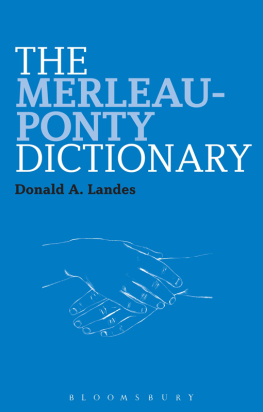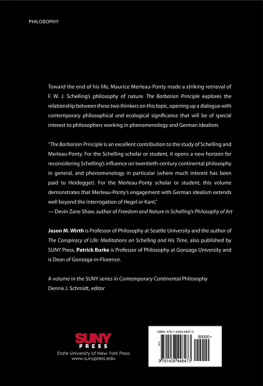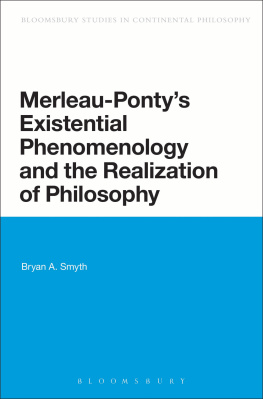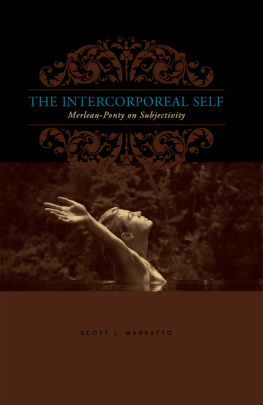Merleau-Ponty and
the Face of the World
Merleau-Ponty and
the Face of the World
Silence, Ethics, Imagination, and Poetic Ontology
Glen A. Mazis
Front cover: Norham, Castle, Sunrise, c. 1845, Joseph Mallord William Turner 17751851. Permission granted Tate, London 2016
Published by State University of New York Press, Albany
2016 State University of New York
All rights reserved
Printed in the United States of America
No part of this book may be used or reproduced in any manner whatsoever without written permission. No part of this book may be stored in a retrieval system or transmitted in any form or by any means including electronic, electrostatic, magnetic tape, mechanical, photocopying, recording, or otherwise without the prior permission in writing of the publisher.
For information, contact State University of New York Press, Albany, NY
www.sunypress.edu
Production, Eileen Nizer
Marketing, Michael Campochiaro
Library of Congress Cataloging-in-Publication Data
Names: Mazis, Glen A., 1951 author.
Title: Merleau-Ponty and the face of the world : silence, ethics, imagination, and poetic ontology / Glen A. Mazis.
Description: Albany : State University of New York Press, 2016. | Includes bibliographical references and index.
Identifiers: LCCN 2016005986 (print) | LCCN 2016029477 (ebook) | ISBN 9781438462318 (hardcover : alk. paper) | ISBN 9781438462301 (pbk. : alk. paper) | ISBN 9781438462325 (e-book)
Subjects: LCSH: Merleau-Ponty, Maurice, 19081961.
Classification: LCC B2430.M3764 M39 2016 (print) | LCC B2430.M3764 (ebook) | DDC 194dc23
LC record available at https://lccn.loc.gov/2016005986
10 9 8 7 6 5 4 3 2 1
This book is dedicated to the memory of Bruce Wilshire, mountain man, philosopher extraordinaire, and dear friend, and to Donna Wilshire, wild woman of the earth spirit, philosopher, and also my dear friend.
Contents
P ART I
E NTERING THE W ORLD OF E XPRESSIVE S ILENCE |
P ART II
F ACES OF THE W ORLD D ESIRING S ENSIBILITY AND E THICS |
P ART III
T HE I MAGINAL , O NEIRIC M ATERIALITY, AND P OETIC L ANGUAGE |
Preface
From Silence to Depth
Like most aspects of thought that relate to the work of Merleau-Ponty, the two main inspirations for this book are interwoven. The first is that we are living through a time that could desperately use the insights of Merleau-Pontys work, since we witness almost daily a destructive inability to connect with others within our cultures and across cultures at a historical juncture that requires greater cooperation. This inability is recognized vaguely to be a result of identifying incorrectly that we are isolated individuals. We cant see how we are part of communities, both local and global, and how even the various parts of our psyches can connect. This uneasy feeling is somehow related to an equal inability to bring nature, culture, history, economics, and technology into a fruitful interconnection, which allows them to remain as colliding forces whose oppositions undermine the quality of life. These were issues that also plagued Merleau-Ponty, but his approach to finding a new way of articulating an ontology, an epistemologyand as I will contend in this bookan ethics is one that is still not fully understood by many scholars and certainly not by the global culture. Merleau-Pontys unique approach to embodiment would offer the contemporary world an understanding of the interconnectedness of self, others, and the world that still incorporates an appreciation of difference that could be vital for discerning more clearly the puzzles of postmodern existence causing global harm.
For Merleau-Ponty, his emphasis on embodiment was not merely a matter of giving the body a more central role in calculating innovative practices; his project was to fathom the bodys ways of apprehending reality in ways that made our more rational and traditional understandings possible. His work articulates how self, others and world are manifest in a radically different way when seen through embodiments hold on reality. His philosophy could be a fruitful way of addressing the contemporary widespread interest in giving the body a more central role in thought and practice. Be it in medicine, psychology, popular culture, or academic disciplines, an emphasis on the role of the body as portent of new meaning and fulfillment is gaining force. Yet, for all this new attentionor even, as one might be tempted to call it, obsessionthe radical shift that a greater comprehension of embodiments sensitive role in understanding self, world, and others in a liberating way is just as distant as in the earlier historical periods when the dismissing and despising of the body seemed more the general rule. The body is still being objectified. As a result, the particular way in which embodiments relations with self, others, and the world yields a very different epistemology, ontology, and ethics is yet to be realized.
This leads to the second inspiration for this book. Given the current interest in embodiment, there is a turn to Merleau-Pontys thought, but some of its most startling dimensions are in danger of being passed by. The emphases of this book are easily overlooked in their importance to the philosophy of embodiment. Yet, these ideas are necessary to bring the cutting edge of Merleau-Pontys unique ontology of the flesh into greater relief. Since there is now within philosophy and other disciplines a spreading recognition of the power of Merleau-Pontys sustained interrogation of the bodys differing and fundamental ways of understanding, it is time to delve more deeply into the radical nature of this understanding. There is a danger that some of its furthest edges and more subtle nuances will be lost as the major outlines of his thought become more popular. Paradoxically, as a philosophy becomes more appreciated, its most radical ideas and important divergences from the norm are often diminishedjust as the rough edges of a stone are smoothed out by greater handling. This book contends that to enter more deeply into Merleau-Pontys understanding of perception and the new ontology to which perception brought him requires following a path into his thought that proceeds in four steps. The first step is to recognize that the power of Merleau-Pontys ontology of the flesh can be fathomed only through understanding the key role of silence in his thought. Without both understanding the unique sense of silence that Merleau-Ponty articulated and then seeing how silence opens us to what Merleau-Ponty called the mute gestures of the world, we will not have access to the level at which person and world are co-emergent, and this is vital to his indirect ontology. Also, in fathoming Merleau-Pontys sense of silence and gestural interchange between person and world, one can appreciate one of the Phenomenology of Perceptions most important conclusions: that perception has demonstrated another meaning of the sense of meaning itself. This sense is further articulated in the lecture courses of the 1950s and in the final writingsthe meaning inscribed by motion itself through perception. There is a give and take of silent exchange that underlies the more deliberate dialogue between us and the world that will emerge in language and reflection. The relation between this type of silence and language is not antithetical. Entering into this silence infuses these dimensions with a dynamic, dialogical import that goes beyond a human-centered ontology. Silences voices are also seen to be enveloping in a way that frontal expression and apprehension are not. Part of Merleau-Pontys fears for the future of humanity was his recognition that the dawning postmodern culture would be unable to hearken to silence. Silence will be examined as to how it allows the reversibility of humanity and the world to emerge in a felt understanding. It will be seen how the opposite is also true: namely, that only the felt sense of reversibility allows silences sense to enter into the perceived depths of the world.

